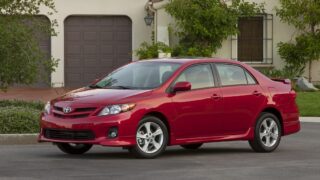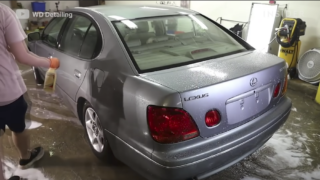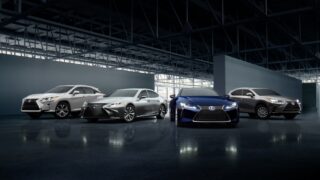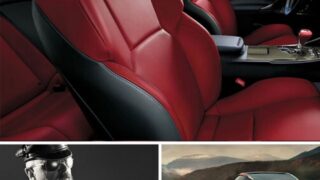2011 Lexus IS250C Convertible Review

Until the IS convertible debuted a couple of years ago, the only
available drop-top model in the Lexus line-up was the pricey SC430,
which starts at over 60K. That V8 430-only-version of the SC line, IMO, was a major marketing
error on Lexus’ part. Several times I suggested a less-expensive V6
SC350 as a more-affordable alternative, yet the Lexus planners turned a
deaf ear, notwithstanding the fact that the first-generation (and IMO
much better-looking) SC series had a highly-successful V6 330 model
that, even today, is popular on the used-car market.
Well, to compound things, not only was a SC350 never added, but the SC430 itself has been dropped from the lineup, and is gone. So, that leaves the IS convertible series as the only Lexus drop-tops still available in the American market. In one sense, though, that’s not totally a bad thing…..the IS convertibles, IMO, especially the IS350C, pretty much take the place of what a less-expensive V6 SC convertible would have been if the Lexus planners had ever bothered to produce one. However, The second-generation SC was known for its superbly-trimmed interior, with acres of finely-polished dark or light-tone wood all over the dash, console, and door panels…..the IS interior, while good enough for Lexus standards, simply does not reach that level of opulence. But, then again, the IS convertibles don’t cost 60-70K, either, like the SC430 did.
In past IS reviews, I’ve gone deeply into the line’s history, introduction, (it was derived from the Toyota Altezza), comparison to the BMW 3-series with which it was intended to compete against, and the general IS strengths and weaknesses. So, I won’t repeat all of that here again…..this, of course, being primarily a Lexus forum, there is enough talk about that among yourselves on the general chat-line and IS sub-forum. In this review, I’ll stick primarily to the convertible line, and what I perceive as the convertible’s strengths and weaknesses.
For 2011, the IS convertible-series comes in three basic versions…..IS250C Manual, IS250C, and IS350C. The 250C and 250C Manual, as the names suggest, come with RWD, a 2.5L V6 with 204 HP / 185 ft-lbs. of torque and the choice of a conventional 6-speed manual or 6-speed Sportshift automatic. The IS350C, also RWD, comes with the automatic and a 3.5L V6 with 305 HP and 277 ft-lbs. of torque. A special, limited-production IS350C F-Sport model will be offered (only 175 will be built) with the 350c’s powertrain, special wheels, lowered-springs, performance suspension, Bi-Xenon headlights, and some special interior trim. Base prices start at $41,190 for the 250c manual and run to $46,640 for the 350c. Unfortunately, the AWD offered on both the IS250 and 350 sedan is not offered on any convertible model……IMO a marketing error, although a number of automakers, not just Lexus, omit AWD from convertibles on the theory that a fair-weather car usually doesn’t need the extra traction. But the secure folding hardtop on the IS convertible series is obviously designed for the elements……so, IMO, should AWD be offered to match. As on the regular IS-sedan series, the 350C is not offered with a manual transmission…….another marketing error, IMO, that keeps the IS from being more competitive with the BMW 3-series.
Even though warm weather is here now to stay (in fact, that’s an understatement…it got as high as 102 degrees, with humidity, last Thursday in D.C.), IS convertibles don’t seem to be readily in stock at Washington-area Lexus shops. IS350 convertibles, because of demand, seem especially hard to find. The Lexus dealer I was at today, for example, only had one IS250 convertible, and no 350 models…..they are waiting for 1 or 2 350s to be delivered next week. Manual-transmission models (which are limited to the IS250 version) are extremely difficult to find. So, for the review, the pickings were slim. I looked over and test-drove the only one they had in stock…a 250C automatic (which is probably the version I would buy if I were shopping for one myself). D.C.-area traffic, some of the most congested in the country, is quite adverse to traditional 3-pedal manual transmissions. The test-car, painted Tungsten Pearl with Black Leather interior, was not my first color-choice either, but had the usual Lexus superbness of paint and fit/finish. It also had a couple of expensive option-packages, which raised the list price to over 48K…rather pricey by IS standards (though 350C and IS-F models, of course, would run even more). However, I was generally pleased with it, and enjoyed the review…..details coming up.
EXTERIOR:
As you first walk up to the IS convertible, the front and rear-ends, of course, look pretty much like that of any other IS model (except the IS-F, which has some special body-fairings). The roofline, of course, is different, but unlike some other fabric-top/folding-hardtop convertibles, this one, IMO, looks pretty good even with the top up….it doesn’t have an awkward look. The folding-hardtop panels are made of a polymer-plastic material, which, like on the older Saturns, I’m a big fan of…..the plastic/polymer strongly resists dents and dings, so you won’t get those annoying little dimples if you park under a chestnut, walnut, oak, etc… tree the wrong time of the year or run into a hailstorm. Nor are you as likely to get those dimples on the hood, either, since it seems to be made of aluminum rather than sheet-steel. Don’t ask me why, because I’m not a metallurgist, but, for some reason, aluminum panels seem to resist dings better than thin-gauge steel ones do.
Using 13 electric motors, at the push of a button, the fully-automatic folding-hardtop lowers in 20 seconds, stowing in the rear of the car…..and allowing at least some some cargo space even with the roof stowed away…more on that later. All of the power-windows (even the ones for the virtually useless rear-seat), drop automatically with the top, but don’t automatically raise back up again….you must raise them back up, with the four switches, separately. Why?……..my guess is that it’s probably a safety-feature in case someone has their arm, neck, hand, or finger in the way, to keep from injury. It will be interesting to see how long the battery lasts in this car, especially if it is not driven enough to keep it fully-charged. The 13 electric motors, all working at once, combined with all the other power-draining accessories on this admittedly upmarket-car, and that is quite a load. Some automakers claim that you can open/close both fabric and folding hard-tops at up to 25 MPH with no damage, but I’m not convinced……..whenever I test a convertible (and as I did with this car), I always come to a full-stop, put it in Park, step on the brake, and only then raise or lower the top. Lexus doesn’t seem to give a speed-recommendation for this one, (or, at least, I couldn’t find one).
Back to the general exterior…..the sheet-metal panels and doors seem to be solid, and the doors close with a reasonably solid “thunk”. The quality of the paint job is the usual Lexus superbness, although, as I mentioned earlier, the silver Tungsten certainly wouldn’t be my first color-choice. This shade of silver was nicely-done, though (as it is on many Mercedes models), and didn’t have much metallic-texture to it, so it was able to shine more than silver usually does. Perhaps the most stunning IS color is the Matador Red (a number of Lexus models offer it, including the IS convertible), which will just knock your socks off. But the nice bright Ultrasonic Blue from the IS-F is not offered on any other IS model, including the convertibles…a marketing error, IMO. Another error is the fact that only 7 colors are offered on the convertibles……IMO, a car this expensive should have a wider choice. Turn-signal indicators are mounted in the two side-mirrors, a nice feature, and the mirror-housings swivel/snap/lock as smooth and slick as an Al Gore press-
conference. The alloy wheels were handsome-looking, IMO, and were shod with 17″ 45-series all-season tires. The front/rear tire-widths, though, are not the same, which will affect tire-rotation. Summer-only, high-performance 40-series tires, with 18-inch wheels, are available as options….so are run-flat tires. There was only one thing on the exterior I specifically didn’t like, besides some of the paint-color restrictions….the lack of standard body-side moldings to help protect from parking-lot dings. Automakers may pinch-pennies on that very low-cost feature (most of the very newest vehicles today omit them), but I’m going to mention it as long as they do….IMO, there’s no excuse for it.
UNDERHOOD:
Open the lightweight-aluminum but still solid-feeling hood, and two nice struts hold it up for you instead of a cheap manual prop-rod (you would be surprised at the number of vehicles that, even at this price, make you fumble with a manual-rod). There is a nice underhood insulation pad, of course……..one of a number of features which helps keep Lexus powertrains so quiet. The uncovered battery, though all the way back on the left, behind the engine, is fairly easily-accessible. But almost everything else under hood, in typical upmarket/premium-car fashion, is hidden by big black plastic covers, including the engine itself. Why premium and luxury-car-manufacturers can’t simply leave things uncovered under the hood for easier-accessibility, like on more inexpensive and entry-level vehicles, beats me. However, the dipsticks, filler-caps and reservoirs are more-or-less easily-reached, even with covers.
INTERIOR:
From the front seat forward, the IS convertible’s interior is pretty-much the same as it is on all the other IS models. So, since I’ve already reviewed several other versions of the second-generation IS interior in detail, I won’t go into a lot of detail here…..just briefly describe the convertible’s interior and its main differences from the sedan’s counterpart. The most obvious difference, of course, is the two doors and the minuscule rear seat, which is virtually useless except for children and as a package-shelf…of course, the one in the sedan is not that much roomier either. Sitting in the drivers’ seat, reaching over your shoulder for the seat-belt can be difficult if the belt is not slipped securely into the slot-guide on the back of the front seat. With the top up, the tiny peep-hole of a rear window is almost as useless for rear vision as the rear seat is for adults. Fortunately, like most convertibles today, the rear-window is glass, not plastic, and has an electric rear-defogger. The ceiling inside, with the top up, is low enough that the seat-cushions up front must be lowered a bit for people my size to fit in under the roof without a lot of rake in the seatback. Otherwise, the interior has the same smooth silky leather, comfortable seats, excellent fit-and-finish, pleasantly-padded dash, killer-stereo-sound, highly-polished wood/carbon-fiber/metallic trim, complex NAV/climate/stereo buttons, and nice clear electro-luminescent gauges that the sedans do.
CARGO AREA/TRUNK:
With the top up, the cleverly-designed trunk-lid (aluminum, I think) opens up, front-hinged, conventional-style, to access a reasonably roomy cargo-area for this type of vehicle. The cargo area is quite well-trimmed, with thin but plush-feeling beige carpet on both the floor and walls. As with many Lexus products (though I think it’s optional on the CT), a standard First-Aid Kit is tucked into a cubby-hole on the left. Lower the automatic top, and the top and its hardware stows into much of the forward-part of the cargo-compartment, but leaves a fairly small area behind it for cargo-space about maybe 14-15 inches long and about 5-6 feet wide. You can fit in a golf-bag, fishing-pole, small skis, etc….., and/or a few smaller packages. One does not expect a convertible this size (it’s more or less a compact-car) to be a Chevy Suburban for hauling, but, for this type of car, it’s not bad. At the rear of the small cargo-area is an optional net to hold bags and packages. Under the floor and a couple of hard-to-reach panels is….yep, you guessed it….a temporary spare tire (on a $48,000 car) instead of a real one. Yes, my old IS300 had a real one……AND a real spare alloy-wheel. Getting to the temporary spare, though, because of the trunk-space that the top takes up when it folds, can be very difficult….Lexus recommends raising the top before trying to get to the spare. As mentioned earlier, run-flat tires are also an option, which eliminates the need for that. The useless rear seats don’t fold down for added cargo space like on many vehicles…..perhaps because of the complexities of trying to fit in the hardware/mechanisms for folding-seats along with the mechanisms needed for the top.
ON THE ROAD:
Start up the smallish 2.5L VVT-i V6 with a nice proximity-fob and push-button, and it idles with the usual turbine-smooth, quiet Lexus refinement. On the road, the smoothness/quietness and refinement remains, and I don’t remember hearing much exhaust noise either, even under moderate-to-hard acceleration. The power level, with only 185 ft-lbs. of torque peaking at a fairly high 4800 RPM, is adequate for most normal driving, (and it would suit me fine), but a number of you would probably want the 3.5L V6 in the IS350C, with its almost 100 extra ft-lbs. of torque at the same 4800 RPM. The 2.5L in the 250C, with RWD, seemed a little peppier than the last time I sampled it with the AWD on the sedan model, even with the added weight of the convertible’s extra frame/chassis-stiffening and folding-top hardware.
The 6-speed Sport-shift automatic, in typical Lexus fashion, like the engine, was also smooth and refined, even with manual paddle-shifting (bump-lever shifting, of course, can also be done in the sport-mode). The automatic IS250C’s EPA-mileage rating is actually a couple of MPG more than the manual…..just one more reason, IMO, to choose it over the hard-to-find manual models. The shift lever has a smooth, slick action, which takes at least some of the annoyance out of the zig-zag P-R-N-D pattern, but I still strongly prefer a simpler fore-aft pattern. An Eco/Power button adjusts throttle response, shift-characteristics, and (supposedly) steering response and suspension firmness…..using it, I felt a small difference in the powertrain, but not much in the chassis, which we’ll get to next.
The chassis-engineering, incorporating, of course, the extra frame-stiffening to compensate for the convertible’s loss of top-down structural-integrity, was quite well-done, though not quite up to the level of the competing BMW 3-series. Still, the ride/handling compromise is generally a good one. I did about half of the test-drive with the top up, and the rest with it down. Top up, the steering response was relatively quick and sports-coupe like, and cornering was quite flat, with little noticeable body-lean. Wind and road noise were both quite low by medium-price convertible standards, and there was no discernible cowl-shake. Road-feel, with the power-steering, seemed improved a little over past IS models I’ve sampled. The ride, in general, was not uncomfortable, but, like on many of today’s vehicles I sample, was a little stiffer than I prefer. With the top down, steering-response remained generally good, and only slightly more body-lean was noticeable. I noticed only a very small amount of cowl-shake/shimmy and windshield-pillar twist…..both used to be a real problem with convertibles, but is vastly reduced with modern engineering. I also didn’t notice much, if any, wind-buffeting in the front seat (which also used to be a problem with some convertibles), even with the relatively low windshield header-height…….a good job by the engineers who designed this particular convertible. I was able to drive at almost any legal speed with the top down and not have my ubiquitous baseball-cap blow off. Because of the relative quiet of the Lexus powertrain and relatively smooth airflow around the car, there wasn’t as much wind/engine noise with the top down as I expected, either. Brakes were another pleasant surprise, with a nice German-sport-sedan-type of firmness/response and lack of sponginess. The brake pedal, unlike that on many vehicles I sample, was relatively well-located for big feet and size-15 clown-shoes. I didn’t have much of a problem with my big shoe catching on the edge of the pedal when going from the gas pedal to brake.
THE VERDICT:
Though it’s a little pricey by IS standards, and more than I myself would want to spend, I don’t consider this car a waste of money by any stretch. It is well-built, has the typical superb Lexus fit/finish, has a good reliability record, is generally pleasant to drive, offers fun in the sun without wind-turbulence in the cabin, has good chassis engineering, a smooth quiet drivetrain, a high-quality interior with slick leather and a killer stereo, a relative lack of annoying cowl-shake, good noise-insulation by convertible standards with the top up, and, of course, the long Lexus warranty and generally good customer-service. The flies in the ointment, though, include a useless rear seat for adults, Peek-a-Boo rear vision (though the optional back-up camera helps), the typical-for-luxury-cars covering-up of most of the underhood components, complex stereo/climate controls with the NAV, and merely adequate power with the 2.5L V6…..a number of buyers would probably spend even more money to get the 3.5L V6 with its much better torque.
But, even so, this is one nice car. IMO, it compares favorably with BMW 3-series convertibles. And, of course, will likely have more-reliable electronics than the typical BMW. If your bank-account can handle it, if you don’t need transportation for much more than two adults, and if you generally drive on roads that don’t need the extra traction of AWD, then go for it.
And, as always…..Happy Car Shopping.
–MM
Want to talk about MMarshall’s review about the IS Convertible? You can join in here: MM Review: 2011 Lexus IS 250c




